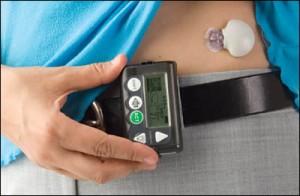The Obesity Epidemic and Juvenile Diabetes
In recent years, there has been a sharp increase in the number of people with type 1 diabetes who are also obese. Even though obesity has been strongly linked to the pathogenesis as well as initiation of type 2 diabetes and a risk factor for complications, very little is known about its role in the development and progression of type 1 diabetes.
Recent studies suggest that obesity plays a role in the development of cardiometabolic complications, dyslipidemia, and insulin resistance in type 1 diabetes.
These co-morbidities may require to be addressed using therapeutic strategies in the context of insulin therapy which has been shown to promote weight gain. Therefore, there’s an urgent need for guidelines for the management as well as prevention of type 1 diabetes.
These clinical recommendations are being developed using a trans-disciplinary research approach addressing molecular mechanisms, metabolism, neuropsychology, novel therapeutics, and lifestyle.
 What is the relationship between obesity and juvenile diabetes?
What is the relationship between obesity and juvenile diabetes?
Type 1 diabetes, which is also known as juvenile diabetes, is a chronic immune-mediated condition that is characterized by the loss of beta cells in susceptible subjects.
Beta cells are mainly responsible for producing insulin in the pancreas. The main genes contributing to juvenile diabetes susceptibility are located in the HLA (Human Leukocyte Antigen) class 2 locus on chromosome 6.
The Human Leukocyte Antigen genes have been linked to about 50% of the familial clustering of juvenile diabetes.
Obesity and overweight are related to type 1 diabetes in various aspects. In addition to being a risk factor for juvenile diabetes, obesity can also be a challenge when it comes to managing and treating the disease.
Moreover, obesity and overweight increase the risk of micro and macro-vascular complications in juvenile diabetes. Such challenges typically arise in adolescence and may become even more common in adults.
Essential points
- Obesity has been known to be a predisposing factor and concurrent phenotype for type 2 diabetes. However, its physiological attributes, consequences, and prevalence in juvenile diabetes are poorly understood.
- As the prevalence of type 1 diabetes increases in the United States and many other parts across the globe, it is important to develop specific guidelines for the treatment and prevention of obesity and the achievement and maintenance of optimal glycemic control in type 1 diabetes.
- The characteristics and role of energy balance in juvenile diabetes are not completely defined and are likely to be affected by both medical therapy and glycemic control.
- Studies show that potential driving mechanisms of obesity in juvenile diabetes include microbiome, epigenetics, genetics, enteroendocrine hormones, and effects on various organs, organelles, cells, and tissues.
- Developing well-defined weight management approaches in people with juvenile diabetes requires a multi-disciplinary research strategy that includes expertise in endocrinology, epidemiology, translational metabolism, exercise physiology, clinical psychology, nutrition, advanced analytics, and mathematical modeling.
The impact of obesity and overweight on juvenile diabetes
It is evident that more studies need to be conducted to understand the role of the whole activity spectrum which includes sedentary behavior, sleep, and physical activity on youth with type 1 diabetes who are obese or overweight.
For example, although research clearly shows that fear of hypoglycemia can be a barrier to engaging in physical activity, its effects can be compounded for young adults who are obese or overweight and have a negative activity toward exercise.
-
Sedentary lifestyle
Youth with type 1 diabetes may also be predisposed to weight gain as a result of supplementing carbohydrates to avoid hypoglycemic events as a result of physical activity. Addressing the role of sedentary behavior, especially reducing screen time, is one intervention strategy that can help expend calories without affecting variability in blood sugar levels.
-
Poor sleep quality
Obesity and overweight may have negative effects on sleep, especially in youth with type 1 diabetes. A 2006 study on adolescents and children revealed that sleep duration has an inverse relationship with obesity in youth, and being overweight increases the risk of a wide range of sleep problems.
Studies show that variations in blood sugar and nocturnal hypoglycemia alter sleep patterns in young adults with type 1 diabetes and thus they face a higher risk for obesity and poor sleep quality than those without diabetes.
Diabetes educators and nurses play a very important role in helping children and adolescents develop appropriate lifestyle behaviors to tackle the prevalent issue of obesity and overweight in youth with type 1 diabetes.
Although clinical care in juvenile diabetes has focused more on accurate carbohydrate counting and good metabolic control, weight control has been grossly overlooked.
Caregivers and healthcare professionals have paid less attention to issues related to sedentary behavior, sleep, and physical activity.
The bottom line
Given the high incidence of obesity and overweight in children and youth with type 1 diabetes, additional studies are needed to explore the consequences and antecedents of excessive weight in type 1 diabetes.
Although this article has identified viable lifestyle modifications for weight management including sedentary behavior, sleep, and physical activity, there’s a need for further research to inform effective intervention strategies for this vulnerable population.

 What is the relationship between obesity and juvenile diabetes?
What is the relationship between obesity and juvenile diabetes?

 Diabetes is a serious condition where the person’s body is failing to get the required amounts of hormone called insulin. This absolutely necessary chemical/hormone called insulin is produced by the pancreas organ. For some unknown reasons to medicine the pancreas organ will stop or slow in the mass production of this vital chemical. This chemical hormone is used by the body to transform the blood sugar glucose in the bloodstream into a fuel that the cells are able to use for cell fuel.
Diabetes is a serious condition where the person’s body is failing to get the required amounts of hormone called insulin. This absolutely necessary chemical/hormone called insulin is produced by the pancreas organ. For some unknown reasons to medicine the pancreas organ will stop or slow in the mass production of this vital chemical. This chemical hormone is used by the body to transform the blood sugar glucose in the bloodstream into a fuel that the cells are able to use for cell fuel.

